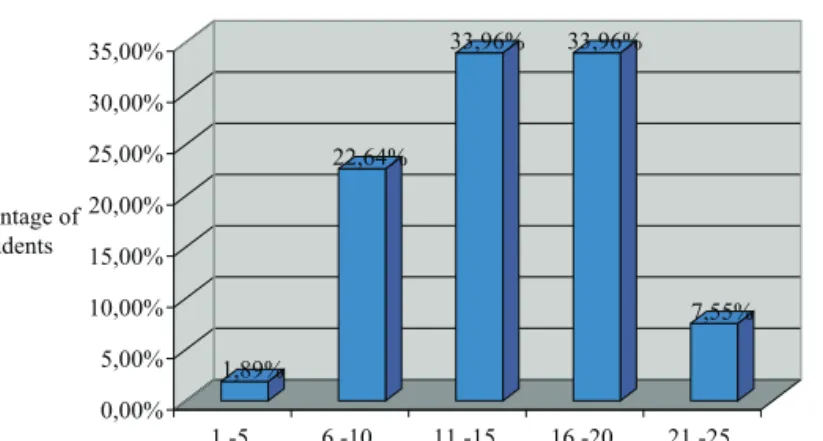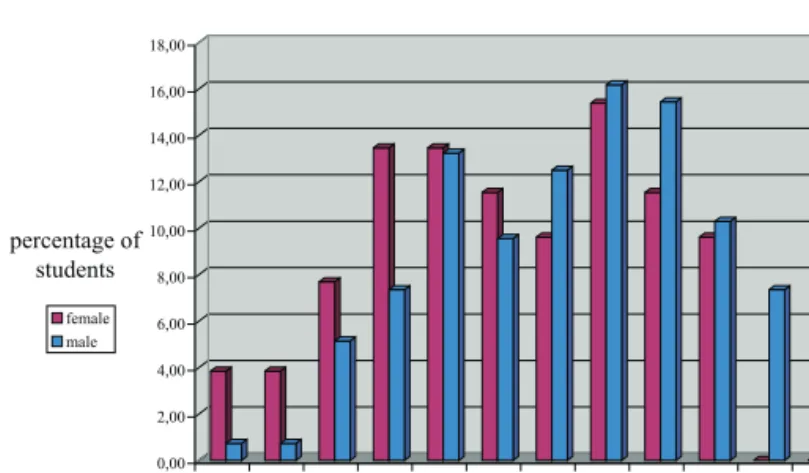(2006) pp. 169–174
http://www.ektf.hu/tanszek/matematika/ami
Gender differences in spatial visualization among engineering students
Brigitta Németh
a, Miklós Hoffmann
baDepartment of Descriptive Geometry and Computer Science Szent István University
e-mail:nemeth.brigitta@ymmfk.szie.hu
bInstitute of Mathematics and Computer Science Károly Eszterházy College
e-mail:hofi@ektf.hu
Submitted 24 August 2006; Accepted 12 November 2006
Abstract
Spatial visualization of engineering students is of greatest importance in terms of their professional achievement, thus evaluation of this skill is essen- tial. Mental Cutting Test (MCT) is one of the most widely used evaluation method for spatial abilities. In this study we present an analysis of MCT results of first-year engineering students, with special emphasis on gender differences. Similarly to other international projects, significant difference is observed between male and female students, which is statistically analyzed in this paper.
Keywords: spatial visualization, spatial skills, MCT, gender differences MSC:51N05
1. Introduction
Spatial visualization is defined by McGee as “the ability to mentally manipulate, rotate, twist or invert pictorally presented stimuli” [8]. The five components of spatial skills are
• spatial perception
• spatial visualization
• mental rotations
169
• mental relations
• spatial orientation
To ascertain students’ mental skills, some standardized tests have been devel- oped, among which Mental Rotation Test (MRT) and Mental Cutting Test (MCT) are of greatest importance. Mental Rotation Test is introduced by Vanderberg and Kuse [9], while Mental Cutting Test, originally developed for entrance examination in the United States [10], has a long history and widely used for testing the spatial ability of students at any level.
There are other tests like Objective Test on Orthographic Projection (OTO) evaluating the effects of the education in orthographic view [1], or Space Imagina- tion Test (TPP) developed by international cooperation in VEGA project [5].
The aim of this paper is to evaluate classical MCT test results of first-year engineering students in Hungary, with special emphasis on gender differences.
Figure 1: An example of MCT problems (the correct answer is 2).
2. The Mental Cutting Test
In our project we used the standard Mental Cutting Test, which consists of 25 problems. In each problem a perspective drawing of a solid body is given, which has been cut by a plane (c.f. Fig.1). Students are asked for choosing the cross section among the 5 given alternatives, always one being correct.
Basically there are two different types of problems can be found in MCT: pattern recognition problems and quantity problems [2]. In the first category one can find strongly different alternatives of possible cross sections, thus the right solution can be found simply by recognizing the pattern of the section from the spatial figure.
In the quantity problems, however, some of the cross sections are similar (more precisely affine) to the correct one, thus the right answer can be determined only by guessing the relative quantities, like ratios of lengths or angles between the edges.
Most of the solids in MCT have relatively complicated, unusual forms, some of them are truncated cubes, others are curved objects, like cylinders. As Tsutsumi et al. reported in [3], failures are mostly based on the fact that students are not able to recognize the spatial form of the object.
Figure 2: Overall results of male students.
Figure 3: Overall results of female students.
3. Results - Gender Differences in MCT
As it is already stated in [3], females “are much less likely to get high scores in the standard MCT”. Similar results have been observed in several countries from Japan through Germany to Poland in an international project by Gorska et al. [4], [7], [5] and even in a recent longitudinal research in Cracow University of Technology [6]. The MCT test in a stereographic circumstances was also used for female students by Tsutsumi et al. [3].
Figure 4: Detailed results of male and female students.
Our purpose was to ascertain the gender differences of Hungarian students in terms of their spatial skills. Here we used the classical MCT test for first-year engineering students of Szent István University.
The test has been filled by 187 students, approximately third of them being female students. Each of the 25 problems counts 1 point, thus the perfect solution yields 25 points. The overall results of the test have been summarized in a way that the range of points has been subdivided into 5 equal parts, 1-5 points, 6-10 points etc. The overall results of male students can be seen in Fig. 2 while Fig. 3 shows the overall results of female students. As one can easily observe from these diagrams, results of female students are strictly worse than that of male students.
Especially remarkable the difference in the highest portion: among the students with best spatial skills the number of females are extremely low. Actually the female student with best result had 21 points, just falling into the highest part.
This fact can even be better examined in the detailed results (c.f. Fig.4). Note, that the same difference can be seen in the lowest interval (1-5 points), but in the opposite meaning: less than 2% of male students achieved 5 or less points, while amongst female students this rate was more than7
.5%.
Statistical analysis of the results also proves this difference. The means and
standard deviances are summarized in Table 1.
male female mean 14.99 12.69 st.dev. 4.71 5.02
Table 1: Basic statistical analysis of the results.
4. Conclusion and further research
Spatial imagination of engineering students has been studied in this paper.
Their abilities were tested by the standard MCT tool which is widely used for this purpose. In accordance with the international experiences we observed relevant differences in male and female students’ abilities. Future work will be focused on the possible gender differences in improvement of their spatial skills through their studies. This work requires longitudinal research with regular testing periods along their university studies.
References
[1] Takeyama, K., Maeguchi, R., Chibana, K., Yoshida, K., Evaluation of Objective Test using a pair of orthographic projections for descriptive geometry.Journal for Geometry and Graphics,3(1999), 99-109.
[2] Tsutsumi, E., A Mental Cutting Test using drawings of intersections, Journal for Geometry and Graphics,8(2004), 117-126.
[3] Tsutsumi, E., Shiina, K., Suzaki, A., Yamanouchi, K., Takaaki, S., Suzuki, K., A Mental Cutting Test on female students using a stereographic system.Journal for Geometry and Graphics,3(1999), 111-119.
[4] Gorska, R., Sorby, S., Leopold, C., Gender differences in visualization skills - an international perspective. The Engineering Design Graphics Journal, 62, (1998), 9-18.
[5] Juscaková, Z., Gorska, R., A pilot study of a new testing method for spatial abilities evaluation.Journal for Geometry and Graphics,7(2003), 237-247.
[6] Gorska, R., Spatial imagination - an overview of the longitudinal research at Cracow University of Technology,Journal for Geometry and Graphics,9(2005), 201-208.
[7] Gorska, R., Sorby, S., Leopold, C., International comparisons of gender differences in spatial visualization and the effect of graphics instruction on the development of these skills.Proc. of the 8th Intl. Conf. of Engineering Comp. Graph. and Descriptive Geom. (ICECGDG), Austin, USA, 1998, 261-266.
[8] McGee, M.G., Human Spatial Abilities: Psychometric studies and environmental, genetic, hormonal and neurological influences,Psychological Bulletin,86, 899-918.
[9] Vanderberg, S.G., Kuse, A.R., Mental Rotations, a group test of three dimensional spatial visualization.Perceptual and Motor Skills,47(1978), 599-604.
[10] CEEB Special aptitude test in spatial relations. College Entrance Examination Board, USA, 1939.
Brigitta Németh
Department of Descriptive Geometry and Compute Science Szent István University
Thököly str. 74.
H-1146 Budapest, Hungary Miklós Hoffmann
Institute of Mathematics and Computer Science Károly Eszterházy College
Leányka str. 4.
H-3300 Eger, Hungary


